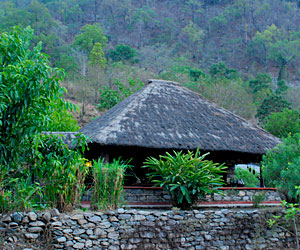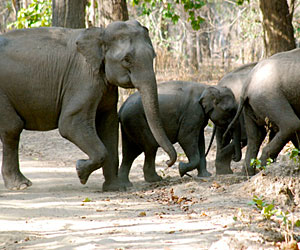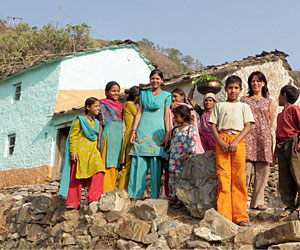A Walk on India’s Wild Side
August 2010
Exploring a Tiger Camp in India’s Corbett National Park
I have been meaning to celebrate my fiftieth birthday in style for two years now.
It seemed that if I didn’t get down to planning some special point in my memory indicating that I was in my fifties, they would flash past me in the kind of rush that my twenties and thirties did. O and yes the forties! I almost forgot about them!
While I don’t have anything against parties as a celebratory rite of passage, for someone who moves around as I do birthdays are also a marker-point in the calendar of my life.
As I enter into my old crone years, I am about building up the memory banks, of storing memories in the treasure chest of my mind so I can pull them out when I am sitting in a wheel chair with my cardigan on inside out and examine the course of my life through all these heart-stopping memories.
 I took myself off to the Corbett National Park with the plan of meeting a tiger or a leopard. Despite the critical situation of the Tiger population in India, currently less than 1200 in the entire country, Corbett Park claims to have 240 of those rare and dignified cats within the confines of their 525 square kilometer park.
I took myself off to the Corbett National Park with the plan of meeting a tiger or a leopard. Despite the critical situation of the Tiger population in India, currently less than 1200 in the entire country, Corbett Park claims to have 240 of those rare and dignified cats within the confines of their 525 square kilometer park.
I began the trip with high expectations of seeing only one species, the solitary and endangered gentlemen of the jungle, the Royal Bengali Tiger. Instead Mother Nature reached out and grabbed me by the senses, and in doing so awoke me to the celebration of nature going on around me.
The sweet lemony smell of curry leaves crushed by the feet of an elephant invaded my brain on the first evening safari into the forest and the days that followed flowed like the water of the rivers that surround the park. Corbett National Park holds an amazing variety of wildlife, from huge pythons to cute little otters, gentle quaking chital deer and rare vultures, sloth bears and elephants and insects too various to mention. The waterways hold a rich variety of fish and crocodiles and the forest is alive with birdsong.
 As we track through the park each day a different face is revealed to us. One morning we come across a group of elephants with these young, who very generously let us photograph from a distance before crashing off into the jungle.
As we track through the park each day a different face is revealed to us. One morning we come across a group of elephants with these young, who very generously let us photograph from a distance before crashing off into the jungle.
Discovering a Luxury Resort Off the Beaten Trail in India
Riverine Woods Resort offers five star luxury in a resort that is so far off the beaten trail that one must cross rivers in a jeep to arrive there and yet not much more than six hours drive from Delhi. Arriving from the Tiger Camp, we are met by a jeep that plows into the river and across rocky paths to a wooden bridge where we are met by the staff of the resort. They carry our bags and direct us along lemon grass planted paths to our traditional thatched roofed huts.
Squeals and splashes from the river call me to the swimming hole which is deep and green and delightfully cool. For the first time in more than a year I am swimming and the feeling of it rejuvenates me. Upriver a family sit in the shallows and wallow deliciously.
I feel like one of the parks many otters, I roll on my back and float and as I do I think of the Goonch fish, another resident of the park, poke my toenails out of the water and count them. All present and accounted for so no goonch lurks in the depths of this swimming hole. Birds of all colors and persuasions flick past, butterflies as big as birds drift by and far up on a hill a mountain goat is sending down  scatters of shingle as he grazes on a vertical slope.
scatters of shingle as he grazes on a vertical slope.
In the evening a bird watching walk along the riverbank and tales of Mahseer fishing in the wintertime. The pristine forests beckon but night is falling and we head back to the camp arranging to wake and hit the trail by 5am in the morning for a village walk five kilometres up the mountains.
Jungle Travel in India
Viewed at this level, the jungle is its own entity, a self-sustaining kingdom with its own rules and languages and borders. The people who live in the edges of this resort are part of a unique profit sharing arrangement with the resort owners. In return for helping to sustain the Mahseer fish, which is a crucial element within the food chain directly affecting the survival of the Tiger, the resort trains and employs local villagers.
When we arrive at 8am, the village has already been awake for hours and the women are heading out to cut grass and food for their cows. The kids crowd around and we sit for chai with a local tailor and his family. The way downhill is faster and undercover of the forest, as gradually the sky begins to change. There is just time for another swim in the river, I try out the bush shampoo plant by bashing the stems on a rock and wash my hair with it, as instructed by our guide. My hair feels silky soft and he promises it also prevents dandruff.
A pre monsoon storm arrives with clouds swirling and lightening cracking and the perfect excuse to cozy up and watch the show from my veranda while the smells of the evening meal wafted teasingly towards me.
Because of the rain and other commitments, we had to leave the resort in the predawn. At 4am we were crossing rivers and trudging through he jungle at a brisk pace towards the jeep.
Then the strangest thing happened. At this ungodly hour of the day, without even the slightest trace of caffeine or any other stimulant in my system I began to sing.
I can only attribute this to post Riverine Woods Euphoria and the feeling of At-one-ment with Nature. I was madly magically at one with Mother Nature, all my birthdays rolled into one.






One thought on “A Walk on India’s Wild Side”